And we’re back in Georgia! Five posts down, half a dozen still to come. Today I’m taking you out of Tbilisi, on my big day out. Friday was the day of longer day trips – there was a trip to Kazbegi, wine tours to Kvareli and Signagi and my choice, Uplistsikhe, an ancient cave town. It was a very easy decision. I don’t drink wine, so the wine tours would be utterly wasted on me, I didn’t fancy a really long day in a bus with strangers virtually to the Russian border and most importantly, I love caves. Quite frankly, whatever the other options were, I would have ended up picking Uplistsikhe.
We were waiting for the various buses under the Big Bicycle Statue when I spied a burst of colour that I recognise from Instagram at the other side of the road, the first person I actually knew – online, not in person. It was the purple vision that is the Barefoot Backpacker! I promptly attached myself to Nel for the rest of the day. I dislike long-ish bus journeys because I’m ludicrously emetophobic and I’d learned on the enamel trip that even travel creators are not immune to travel sickness. Nel, I was reasonably sure, is, and they looked a bit baffled when I said “Important question: do you get travel sick? Ever?” (“…No? Never?”) so they were safe to sit with for the trip. It’s good to get to meet people you know online in real life and to bore each other with your tales of real life work in data research and analysis and to be be protected from whatever else might be going on elsewhere on the bus.
We went through Gori on the way, partly because Gori is the nearest major town and the route can go through it but mostly, I think, to take a look at the Stalin museum. Gori has a love-hate relationship with the great dictator who happened to be born there. On the one hand, they’re not proud of him – who would be? On the other, we were told that he’s the only thing that’s ever come out of the city and some sort of civic pride means they’re kind of compelled to mention him. For the sake of Gori, I’d like to point out that the town has produced four Olympians who’ve won three Bronzes, three Silvers and two Golds between them – that’s eight Olympic medals from Gori and that’s impressive enough that maybe Gori should be selling itself as “Georgia’s Olympic town” rather than “Georgia’s embarrassed dictator birthplace”.
Stalin in brief: the house where he was born is now inside some kind of colonnaded monument and the district has been flattened and turned into a museum and park, with his private bulletproof train coach parked out the back. We didn’t stop, just gawped at it as we passed but I gather the done thing if you visit is to have a debate about whether it’s right to have a museum to the man or not. Even Gori isn’t sure. This museum is probably the biggest moneymaker in the whole town and it’s important to not forget or bury things from history but on the other hand, a fairly spectacular museum veers very close to glorifying several decades of atrocities.
But this isn’t about Gori or Stalin. It’s about caves! It’s a quick run down the road from Gori to the car park at the entrance. We were greeted, as usual, by a pack of stray dogs, one of whom attached herself to us for the rest of the trip.
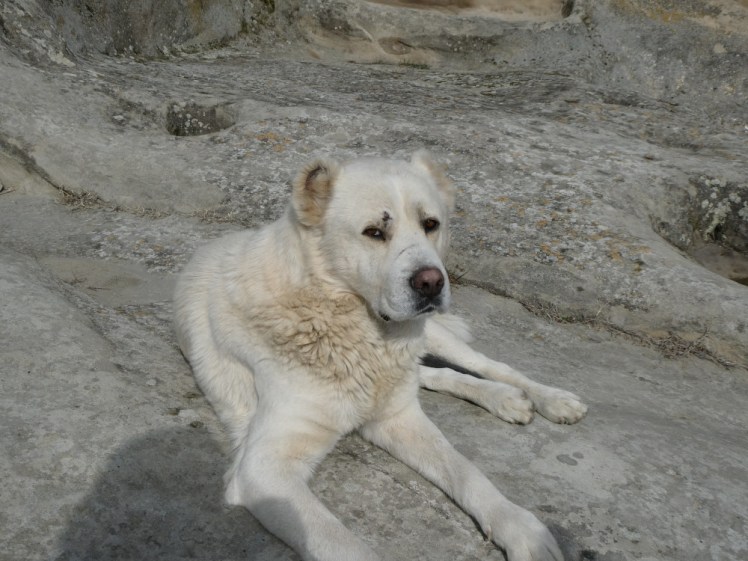
Uplistsikhe is somewhere around four or five thousand years old and carved straight into the limestone mountainside. There’s a river running along the bottom, which means an easy source of water, views for miles around which means you can see your enemies approaching and an abandoned town on the plain behind the hill. I think I was kind of expecting something quite primitive, rough-hewn caves that look like they were carved with sledgehammers but even today, after four/five thousand years of erosion, weathering and neglect, it’s very visibly a large complex settlement. I think you need a guide to show you what you’re actually seeing. Left to my own devices, I think I’d have enjoyed it hugely but had no idea what it’s actually like.

So, entry is via quite a large flight of stairs – not original. The dog scampered up the bare rock next to us and then we were in the city, which feels more like it’s on top of the hill than on the side of it. Seeing how many ceilings have collapsed, I wonder how much more hill there was when Uplistsikhe was new. My expertise, such as it is, is in caves carved out by flowing water and calcium formations, rather than caves carved out by humans and left exposed to the fresh air. For what it’s worth, limestone is limestone and my inner caver found herself stroking and smelling the rock. I was tempted to lick it – we all know the thing about which sciences you can lick, and rocks are so very lickable. I did not do it. I don’t know who’s touched that rock over the last five thousand years. But I’m drawn to limestone like a volcanologist to fresh lava.

First things first, the water channels. There are channels running across the rock, about six inches wide and about as deep and criss-crossing the entire settlement. I don’t know if that’s drinking water or draining or even sewage but certainly it was for moving water around. This is Georgia, so naturally there are wine cellars. I don’t think there were are qvevri, the large clay vessels sunk into the ground for wine to ferment in but the holes were there and the storage rooms were there. We saw rooms with pegs carved into the walls for hanging things, and holes where shelves would have been mounted. Back in the day, these probably wouldn’t have been as dramatically different from your and my homes as you imagine when you look at the bare rock. There probably would have been doors, at least on the interior rooms and probably on the outside. Out on the “main road”, the smooth wide rock that runs between visible cave buildings, there were roadside jails. They’re about eight feet deep, sunken cones with grills over the top. Yes, cones. It means prisoners can’t sit down because they narrow too much at the bottom, and because they’re right by the road, it means anyone going about their business can see them and tut at them.


Other things I wouldn’t have recognised: there’s an entire theatre. It has a very elaborate ceiling over the stage and then the seating would have been a kind of shallow amphitheatre outside in the open air. If I was a Georgian musician or comedian, I’d absolutely stage a show here, like Bjork did at Kerið crater. There was a pharmacy – what I understood to be the counter or the storage was actually rebuilt in the Soviet era and isn’t original but it gives you an idea of what it would have looked like.
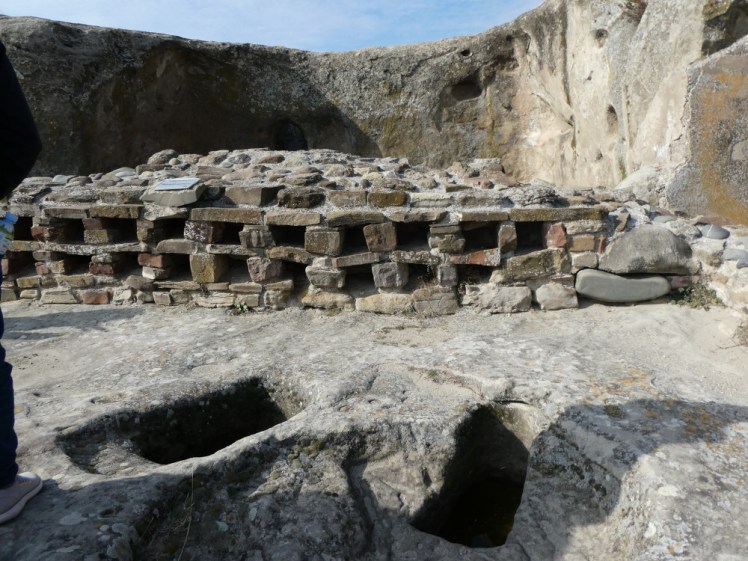
Down below, there’s a place of worship, which would have started as a fire temple but over the millennia, might have become a Christian church. Up above is definitely a Christian church, very out of place here. This thing looks like when you stick a glass tower in a medieval walled town but it’s pretty ancient in itself. I can’t quite date it but somewhere around the ninth or tenth century. Back home, anything pre-Conquest is pretty ancient and this could comfortably be two hundred years older than that. It was bright and sunny, if a little chilly, outside and as you step up and into the church, the darkness inside blinds you for a moment to what you initially take as a sheepskin rug and then almost immediately realise is just a very fluffy yellow-white dog lying in the sun. We were in full tourist mode, crowding through to look inside the church and failing to notice the basket of head coverings and skirts until one of the women at the desk came in to demand head coverings on and hats off. Remote it may be, but this is still a working Orthodox church where you need to follow the rules and we were so preoccupied with the giant open-air museum that we never even thought about that. Sorry, Uplistsikhe. Anyone reading this, please remember to dress appropriately if you’re visiting!

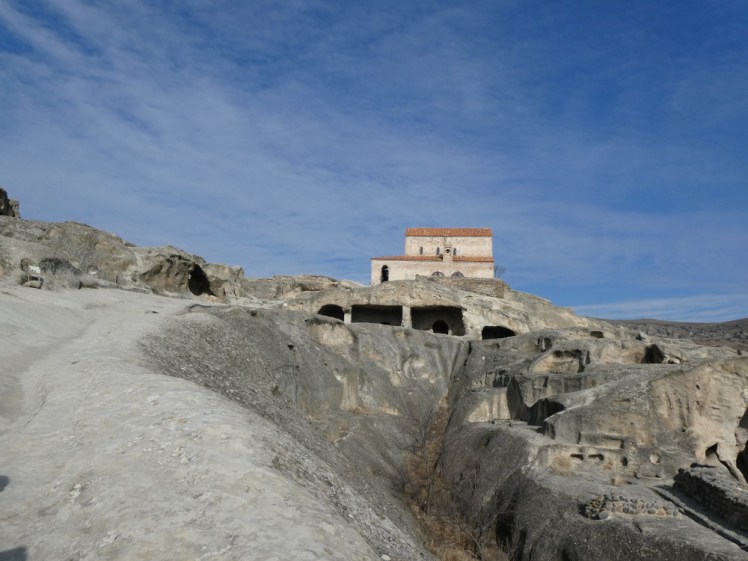
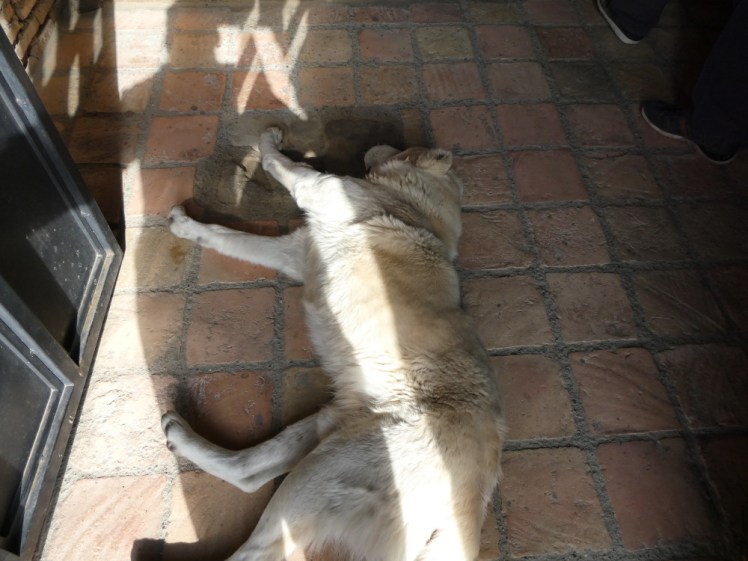

We only had fifteen minutes to ourselves to prowl, explore and take photos after that. Our specialist guide had to go back to meet her next group and Lela had other plans for the rest of the day. I could have spent at least another three hours being guided around this place in detail and at least two hours on my own but it was not to be. Fifteen minutes to go and look at everything we hadn’t already been shown, at the entire expanse of city higher up. Take in the views across mile after mile of open countryside, look down at the more recent abandoned village below.



It felt very remote because we know we’re ten minutes or so from Gori and an hour and a half from the big city. But when Uplistsikhe was founded, it was the big city. This wasn’t remote, this was the heart of civilisation. Half of Uplistsikhe’s history happened before Tbilisi was ever founded. Nearly half of it happened before proto-Georgia even existed. As I write this, it occurs to me that Uplistsikhe is about a thousand years older than the Iron Age hillforts scattered around the area where I live and that Uplistsikhe is, in its way, a kind of hillfort – in that it’s a structure built on a raised piece of land that can be easily defended. I could blather forever in an extremely uneducated way on the parallels between Uplistsikhe and hillforts but I won’t. It’s just blowing my mind a little that the tribes battling on Maiden Castle would have looked at Uplistsikhe, if they’d known it existed, in the same way I look at Winchester Cathedral.
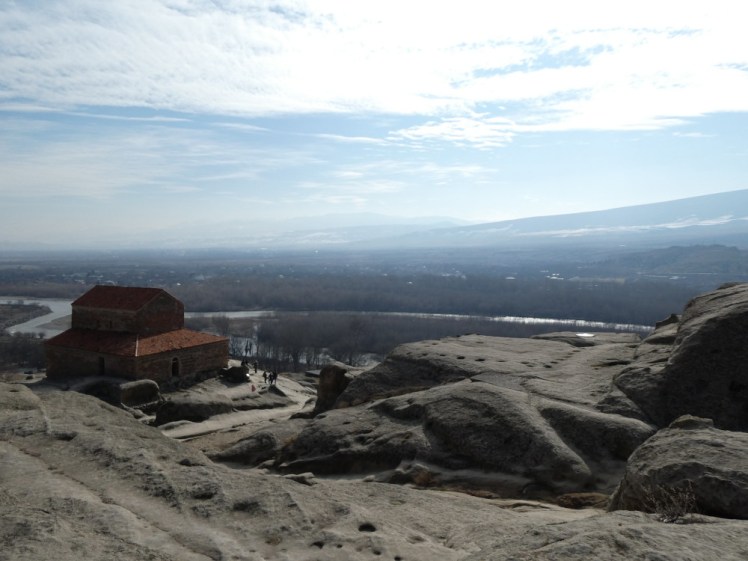
Uplistsikhe continued to be an important settlement for a long time. Some of the Silk Road routes ran through Georgia, following the Kura River, making it a trade centre. It was a major political and religious town, although those jobs were largely taken with the founding of Tbilisi and Mtsketa, and it was an important Georgian stronghold during the Arab Conquests of the 8th to 10th centuries. Eventually, though, it was abandoned and now it’s a curiosity for tourists. A lot of it remains to be excavated and what’s there could do with TLC. Some of the Soviet stuff needs to be replaced and some of the caves that still have roofs are being held up by ugly concrete pillars.
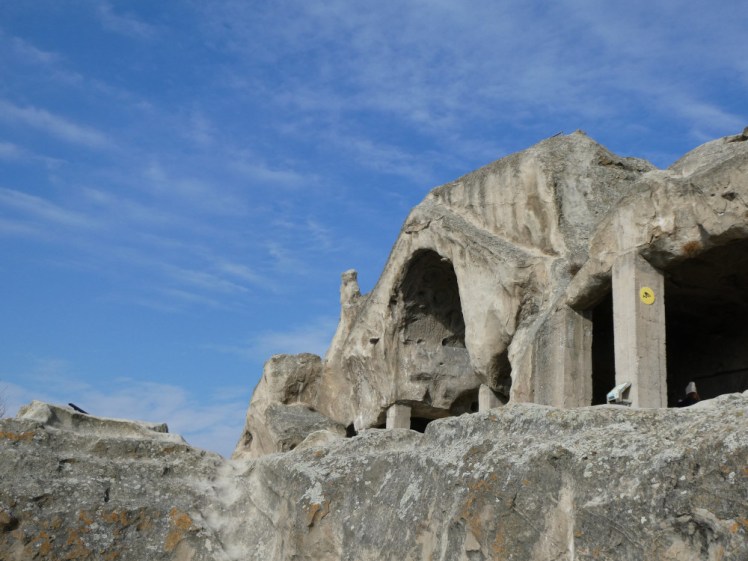
Anyway, our time was over all too soon. Lela led us back to the bus not via the staircase but via the “secret tunnel”. I love a secret tunnel. This one was definitely water-hewn. I know those swirling smooth sides. Again, the staircase that ran down it isn’t original but the tunnel itself is. This served a couple of purposes in Uplistsikhe. It would have been an emergency escape and I think it would also have been a kind of emergency storm drain to run off major floods.

The plan according to the itinerary was to go home. The time given the day before had been 10-3 but when I checked it in the morning, it was 10-4. In fact, it was only about 5.45pm by the time we got back, having stopped at Mtskheta for another supra, a Georgian feast, at the same restaurant we’d stopped at on the way back from the enamel class. This time we didn’t have a tour of Mtskheta or the cathedral but we had just about enough time for anyone who hadn’t done it yesterday to spring around town and take a quick look at everything. Again, not going to talk about the lunch but there will be a whole post on Georgian food and wine coming in a couple of weeks.
My day didn’t finish there, either. I declined the Traverse drinks party and went to another sulphur bath.